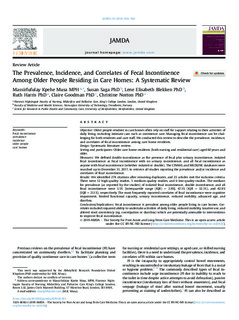| dc.contributor.author | Musa, Massirfufulay Kpehe | |
| dc.contributor.author | Saga, Susan | |
| dc.contributor.author | Blekken, Lene Elisabeth | |
| dc.contributor.author | Harris, Ruth | |
| dc.contributor.author | Goodman, Claire | |
| dc.contributor.author | Norton, Christine | |
| dc.date.accessioned | 2020-03-03T09:59:43Z | |
| dc.date.available | 2020-03-03T09:59:43Z | |
| dc.date.created | 2019-05-27T12:12:51Z | |
| dc.date.issued | 2019 | |
| dc.identifier.citation | Journal of the American Medical Directors Association. 2019, 20 (8), 956-962. | nb_NO |
| dc.identifier.issn | 1525-8610 | |
| dc.identifier.uri | http://hdl.handle.net/11250/2644863 | |
| dc.description.abstract | Objective
Older people resident in care homes often rely on staff for support relating to their activities of daily living, including intimate care such as continence care. Managing fecal incontinence can be challenging for both residents and care staff. We conducted this review to describe the prevalence, incidence, and correlates of fecal incontinence among care home residents.
Design
Systematic literature review.
Setting and participants
Older care home residents (both nursing and residential care) aged 60 years and older.
Measures
We defined double incontinence as the presence of fecal plus urinary incontinence, isolated fecal incontinence as fecal incontinence with no urinary incontinence, and all fecal incontinence as anyone with fecal incontinence (whether isolated or double). The CINAHL and MEDLINE databases were searched up to December 31, 2017, to retrieve all studies reporting the prevalence and/or incidence and correlates of fecal incontinence.
Results
We identified 278 citations after removing duplicates, and 23 articles met the inclusion criteria. There were 12 high-quality studies, 5 medium-quality studies, and 6 low-quality studies. The medians for prevalence (as reported by the studies) of isolated fecal incontinence, double incontinence, and all fecal incontinence were 3.5% [interquartile range (IQR) = 2.8%], 47.1% (IQR = 32.1%), and 42.8% (IQR = 21.1%), respectively. The most frequently reported correlates of fecal incontinence were cognitive impairment, limited functional capacity, urinary incontinence, reduced mobility, advanced age, and diarrhea.
Conclusions/Implications
Fecal incontinence is prevalent among older people living in care homes. Correlates included impaired ability to undertake activities of daily living, reduced mobility, laxative use, and altered stool consistency (eg, constipation or diarrhea) which are potentially amenable to interventions to improve fecal incontinence. | nb_NO |
| dc.language.iso | eng | nb_NO |
| dc.publisher | Elsevier | nb_NO |
| dc.rights | Attribution-NonCommercial-NoDerivatives 4.0 Internasjonal | * |
| dc.rights.uri | http://creativecommons.org/licenses/by-nc-nd/4.0/deed.no | * |
| dc.title | The prevalence, incidence, and correlates of fecal incontinence among older people residing in care homes: A systematic review | nb_NO |
| dc.type | Journal article | nb_NO |
| dc.type | Peer reviewed | nb_NO |
| dc.description.version | publishedVersion | nb_NO |
| dc.source.pagenumber | 956-962 | nb_NO |
| dc.source.volume | 20 | nb_NO |
| dc.source.journal | Journal of the American Medical Directors Association | nb_NO |
| dc.source.issue | 8 | nb_NO |
| dc.identifier.doi | 10.1016/j.jamda.2019.03.033 | |
| dc.identifier.cristin | 1700421 | |
| dc.description.localcode | (C) 2019 AMDAeThe Society for Post-Acute and Long-Term Care Medicine. This is an open access articleunder the CC BY-NC-ND license (http://creativecommons.org/licenses/by-nc-nd/4.0/) | nb_NO |
| cristin.unitcode | 194,65,20,0 | |
| cristin.unitname | Institutt for samfunnsmedisin og sykepleie | |
| cristin.ispublished | true | |
| cristin.fulltext | original | |
| cristin.qualitycode | 1 | |

